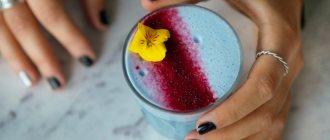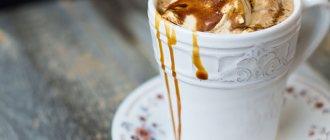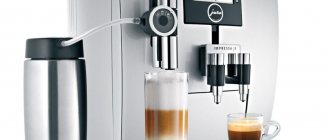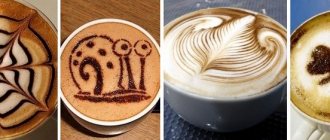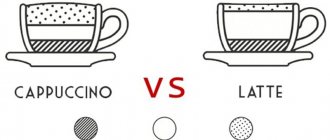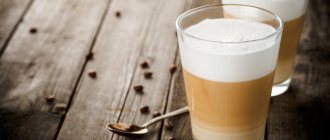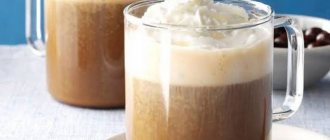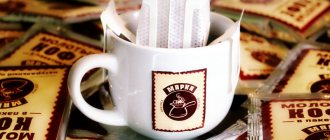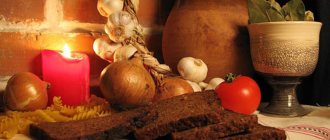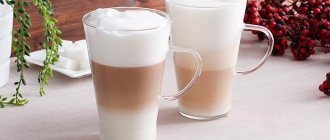A cup of coffee with a pattern on milk foam is a signature feature of many coffee shops and cafes. For the establishment, this is a way to attract new visitors; for the barista, it is an opportunity to show their imagination and creativity.
Doing something like this at home for someone who has not undergone special training and does not have the same technical capabilities as a professional barista is not easy, but you have to try.
If successful, you will present your loved one not just “coffee in bed” (although this is already great), but confirmation of sincere feelings, if it is, for example, a cup with the inscription “I love you” on the foam or a drawing of a heart.
By the way, we talked about who a barista is in a separate article.
What is latte art
Latte art is the art of drawing certain images on coffee foam. This original idea came from Italian monks. True, not many people remember this now. Creating beautiful patterns and original inscriptions on the surface of the drink has already begun in all corners of the planet.
Coffee art is an opportunity to show your imagination. Certain coffee shops even offer a unique service.
The visitor shows a photo on his smartphone, it is transferred to the coffee machine, and this image is reproduced on the latte or cappuccino.
Introduction
Today it is difficult to imagine a cappuccino or latte without a design, even the simplest and most uncomplicated one. It has become a matter of principle for baristas around the world to learn how to pour frothed milk into espresso in a way that turns a cup of delicious drink into a work of art. Thanks to training centers and courses, latte art has taken a separate place in the coffee industry. Annual championships make this trend more and more popular, raising the barista’s quality of work and skill to a new level.
Secrets of drawing for black coffee
The drawings are created on dense milk foam. Only in this case will it be possible to make the perfect decoration. However, if desired, you can apply the pattern to espresso. Drawing on coffee is not difficult.
The easiest way is to create a base. The surface of the drink is sprinkled with cocoa powder. Pour it into a cup in an even layer using a strainer or salt shaker.
Cinnamon can be used as a base. Against its background, the drawing will be contrasting and bright.
What kind of coffee can you draw on?
For drawing, use strong, thick coffee - cappuccino or espresso, prepared according to all the rules in a coffee machine. A latte will also be suitable for this purpose, only in this case dark (for example, chocolate) patterns will be applied to the white background of the drink, rather than milk patterns on top of the dark-colored espresso. You can find latte coffee recipes in this article.
The instructions for beginning artists emphasize that the main component of success is good milk foam , which is used to apply the drawing. However, your own coffee foam is also extremely important - in a well-prepared drink, it lasts for a long time, giving the master the opportunity to create. Sometimes this foam is sprinkled with cocoa powder, and this adds additional beige shades to the traditional coffee color scheme. Information about the benefits and harms of cocoa powder can be found here. Read the following article to learn how to properly froth milk for cappuccino.
Techniques for painting on milk foam
They make drawings on coffee using different techniques. Typically, the following are used:
- pitching. When applying this method, a pitcher is used. This is a kind of jug, equipped with a sharp spout. In this case, the foam is poured into the coffee, and the selected image is immediately drawn on it;
- etching. This technique involves using a sharp, thin stick. For example, you can take a toothpick. It is immersed through the foam so that the tip comes into contact with the coffee. After this, an image is applied by combining milk foam and espresso;
- mixed media . In this case, two methods are used at once: etching and pitching;
- stencil method. The method is considered the simplest. It is with its use that it is recommended to begin mastering the art of latte art. In this case, you need to buy or make a stencil yourself, which is then applied to the cup. In this case, the surface is sprinkled with grated chocolate, cocoa or cinnamon;
- volumetric technique. When used, it is possible to create three-dimensional images from thick foam;
- engraving. The method involves the use of syrup. With its help, an image is created on the surface or an inscription is made.
Etching
Pitching
Stencils
Volumetric drawing
A cup of painting, please!
The idea of combining fine and culinary arts is not new, but how captivating is the coffee and milk base, which can hold a picture, patterns or phrases for some time without mixing or dissolving them. The idea was appreciated and approved by many lovers of everything extraordinary. Coffee with a pattern became popular at birthday celebrations, at family celebrations, and at small anniversaries of lovers. It turned out that with the help of a coffee cup you can confess your love, propose marriage, ask for forgiveness, and evoke the most joyful emotions. The power of art, coupled with an invigorating aroma, has created a whole movement called latte art. There is no exact information about the brilliant inventor of coffee and milk pictures. The origin of this fleeting but amazing art is associated with the order of Capuchin monks living in Italy. Just think, cappuccino is really in tune with the Capuchins, although some see a connection only with the dark brown robes of the monks. The version with a Capuchin barista, for whom drawing on coffee is more important than prayers and fasting, is very dubious, but very cute.
But the name of the distributor of latte art fame is known to all fans of the coffee ceremony; this is the American David Schomer, owner of the chain of popular coffee shops “Espresso Vivace”. David, in the pages of his book and in numerous articles, described the secret of making the perfect latte art, from tools to temperature features and milk foam density. And by the way, Shomer does not hide the fact that he learned these skills from modern Italians, but without mentioning the Capuchin monks. Today, coffee pictures have become so popular that special competitions are organized where the boundaries of cooking, painting and sculpture are finally mixed to the delight of the audience and the jury.
Essential Drawing Tools
When planning to draw on coffee, you must first prepare all the necessary tools. During the work process you may need the following:
- pitcher It is considered the main one among the instruments. It is designed to froth milk manually. In addition, it will act as a kind of pencil;
- salt shaker It is filled with cocoa, which is necessary to create an image on espresso;
- wooden sticks . They are used when making thin lines;
- cream injector. Used when outlining contours. It can be replaced with a tube with a thin tip or a ready-made can filled with liquid chocolate.
COFFEE ART: COFFEE PAINTING
Coffee painting is a popular trend in contemporary pop art. The arsenal of the coffee palette has many shades: from sandy cream to dark brown, from delicate latte to black as night, espresso. The style of artists working in the style of “coffee painting” is also diverse: from classical realism to modern avant-garde.
The variety of paintings in which artists use coffee instead of conventional paints cannot be described at once. Moreover, classify them according to styles, genres and manner of depiction. In this article we will try to make a brief selection of paintings of the “classic look”, if such a definition is at all appropriate in relation to coffee painting . The unusual nature of the existence of such graphics can be traced even in the fact that artists working in this manner often became known to a wide range of viewers thanks to social networks. An example of creativity, when coffee grounds, water and brushes, combined with talent, become a work of art, can be considered the graphics of artists Angela Sarkela -Saur and Andy Saur.
The couple has been interested in coffee painting for more than 10 years. The art of these artists (Coffee Artists™) has received recognition throughout the world. The themes of their paintings are portraits of people, images of birds and animals, landscapes, etc. Initially, they focused on the demand for original design for coffee houses and coffee shops in the United States. Angela Sarkela and Andy Saur planned to hold their first exhibition in one of the Minnesota coffee shops. Well, since it was supposed to take place in a coffee shop, the young people decided that it would be advisable to use coffee as a creative material. By brewing strong and thick coffee and diluting it with water, the experimenters selected different shades of brown.
Just like the Renaissance artists once upon a time, Angela and Andy eventually learned to make pigments for their “coffee paints” with their own hands, developing a special technology for processing 100% coffee. Using them, masters achieve stunning similarities between their coffee paintings and paintings made with acrylic or watercolor paints.
As already mentioned, here we provide examples of coffee painting in the “classical style”. The creative couple has many other works, which can be viewed by visiting their online gallery https://coffeeart.com/gallery/
German artist Adam Cieslik , better known on social networks as NeutrinoZ, also uses coffee instead of paints when painting on canvas. This artist’s slightly gloomy coffee painting still surprises with its realism.
In the “ Coffee Book ,” which we mentioned in the article about domestic fantasy with a culinary slant, the magnificent poetic quotes about coffee are illustrated by drawings by the Brazilian artist Dirceu Veiga . This resident of Brazil, which is the world leader in coffee production, simply had to come up with the idea of using coffee instead of paints. Portraits of celebrities who have already left this world seem to have acquired a noble coffee bitterness from this.
You can see his other illustrations, as well as enjoy poetry dedicated to the aromatic drink, in the above article.
Artistic images in the work of the British artist Maria A. Aristidou are also born thanks to the aromatic drink. And just like most artists in modern pop culture, Maria is better known on the World Wide Web as ma_aris. You can often see this logo in her works.
Such paintings are reminiscent of watercolor works in their execution technique. They are just as airy and light, but Maria A. Aristidou can create more saturated colors. To achieve the desired result, she uses five different coffee blends, brewing each separately. By mixing them, she creates a palette of shades of varying coffee color saturation.
The thematic range of Maria A. Aristidou's work is very wide: the artist paints portraits of celebrities, cartoon and fantasy characters, animals, birds and flowers. The food art direction of the paintings is very organic for her work, because by her main profession she is an illustrator and cake designer.
Coffee painting by Maria A. Aristidou can also be viewed on her Facebook page https://www.facebook.com/Maria.A.Aristidou
Today we can say that coffee painting is popular in all parts of the world. More recently, a Filipino girl, a landscape designer by profession, took up the project. Now she lives in China, and is known online as aeonsiege. She explains her I-Net status as an abbreviation: a combination of the last syllable of her first name and the first syllable of her last name. It’s hard to believe that a newcomer to coffee painting can create simply stunning portraits using a pencil and coffee infusion. A pathetic explanation for such virtuosity can be that she has been drawing portraits since she was 12 years old and has long been in love with monochrome art, especially sepia, which her work is so similar to.
More works can be viewed on her website https://aeonsiege.deviantart.com/
Of course, speaking about the “classic style” in coffee painting, it is impossible not to mention the American artist
Karen Eland.
Unlike numerous apologists of coffee painting, Karen can be considered a living classic of this style. Back in 1997, she began experimenting with leftover espresso coffee in her work, accidentally drawing attention to its colorful, deep brown coloring. It must be said that at that time the term “espresso” was associated more with a high-speed train than with coffee... Gradually, she not only mastered the difficult technique of coffee painting, but also, using it, began to recreate reproductions of paintings by such painting classics as Degas, Matisse, da Vinci, Picasso and others. Karen Eland's works could be called copies, if not for one nuance: she does not simply copy paintings, but introduces into many of them a small author's addition, which very harmoniously corresponds to the very genre of coffee painting and revives the world classic: this is a cup of prepared aromatic coffee.
Most often, Karen paints in coffee shops, surrounded by the exquisite aroma of freshly brewed coffee and the sounds of muffled conversations... “This environment is extremely inspiring,” says the artist and hopes that each of her paintings will immerse the viewer in the same pleasant atmosphere in which it was created. The artist initially uses espresso coffee to create her paintings. Because of its consistency, it is much better suited as a natural dye. Sometimes she lets the drink sit for a few days to get even deeper and darker tones.
Portraying classic female characters as coffee lovers, the cheerful American sometimes gives them funny names. For example, Mona Lisa (“Mona Lisa”), holding a cup of latte, was renamed Mona Latte.
The same applies to the names of the paintings. So, “The Creation of Adam” by Michelangelo in the coffee version by Karen Eland became known as “The Creation of Espresso”
The paintings of this American woman are generally characterized by comic irony. Karen even invited Rodin’s “The Thinker” for a coffee break
